herethere引导的倒装句
倒装句可分为全部倒装和部分倒装

倒装句可分为全部倒装和部分倒装倒装句可分为全部倒装和部分倒装全部倒装是只将句⼦中的谓语动词全部置于主语之前。
此结构通常只⽤与⼀般现在时和⼀般过去时。
常见的结构有:1) here, there, now, then, thus等副词置于句⾸, 谓语动词常⽤be, come, go, lie, run。
There goes the bell.Then came the chairman.Here is your letter.2) 表⽰运动⽅向的副词或地点状语置于句⾸,谓语表⽰运动的动词。
Out rushed a missile from under the bomber.Ahead sat an old woman.注意:上述全部倒装的句型结构的主语必须是名词,如果主语是⼈称代词则不能完全倒装。
Here he comes.Away they went.部分倒装是指将谓语的⼀部分如助动词或情态倒装⾄主语之前。
如果句中的谓语没有助动词或情态动词,则需添加助动词do, does或did,并将其置于主语之前。
1)句⾸为否定或半否定的词语,如no, not, never, seldom, little, hardly, at no time, in no way, not until… 等。
Never have I seen such a performance.Nowhere will you find the answer to this question.Not until the child fell asleep did the mother leave the room.当Not until引出主从复合句,主句倒装,从句不倒装。
注意:如否定词不在句⾸不倒装。
I have never seen such a performance.The mother didn't leave the room until the child fell asleep.典型例题1)Why can't I smoke here?At no time___ in the meeting-roomA. is smoking permittedB.smoking is permittedC. smoking is it permittedD.does smoking permit答案A. 这是⼀个倒装问题。
倒装句
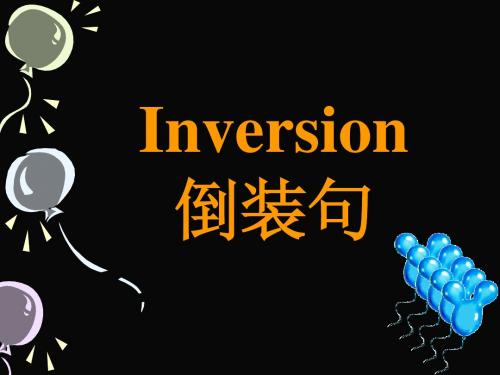
3) He stayed in bed only when he was seriously ill. —Only when he was seriously ill, did he stay in bed. 注意: 如果句子为主从复合句,则主句倒装,从句不倒装。
* Only Pan can speak Japanese fluently in our class. 如果only修饰的是句子的主语,则无需倒装
1. In each class are 42 students. 2. Happy are those who have a sound mind and body.
2. 部分倒装
1)句首为否定词语,如:no, not, never, seldom, little, hardly, scarcely, barely, not a …; not a single …; by no means, at no time, in no way, in no case, on no account, in/ under no circumstances; not only…but also; not until; hardly…when … 等。
注意: 当so引出的句子用以对上文内容加以证实或肯定时, 不可用倒装结构。意为“的确如此”。
* He is American and he can‘t speak Chinese. So it is with his wife.
典型例题
1) ---Do you know Jim quarrelled with his brother? ---I don't know, _____. A. nor don‘t I care B. nor do I care C. I don‘t care neither D. I don’t care also
here there 引导的倒装句知识分享
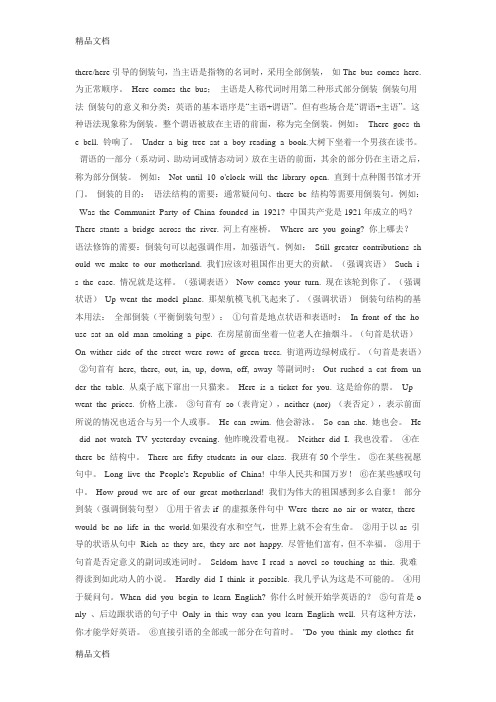
there/here引导的倒装句,当主语是指物的名词时,采用全部倒装,如The bus comes here.为正常顺序。
Here comes the bus;主语是人称代词时用第二种形式部分倒装倒装句用法倒装句的意义和分类:英语的基本语序是“主语+谓语”。
但有些场合是“谓语+主语”。
这种语法现象称为倒装。
整个谓语被放在主语的前面,称为完全倒装。
例如:There goes th e bell. 铃响了。
Under a big tree sat a boy reading a book.大树下坐着一个男孩在读书。
谓语的一部分(系动词、助动词或情态动词)放在主语的前面,其余的部分仍在主语之后,称为部分倒装。
例如:Not until 10 o'clock will the library open. 直到十点种图书馆才开门。
倒装的目的:语法结构的需要:通常疑问句、there be 结构等需要用倒装句。
例如:Was the Communist Party of China founded in 1921? 中国共产党是1921年成立的吗?There stants a bridge across the river. 河上有座桥。
Where are you going? 你上哪去?语法修饰的需要:倒装句可以起强调作用,加强语气。
例如:Still greater contributions sh ould we make to our motherland. 我们应该对祖国作出更大的贡献。
(强调宾语)Such i s the case. 情况就是这样。
(强调表语)Now comes your turn. 现在该轮到你了。
(强调状语)Up went the model plane. 那架航模飞机飞起来了。
(强调状语)倒装句结构的基本用法:全部倒装(平衡倒装句型):①句首是地点状语和表语时:In front of the ho use sat an old man smoking a pipe. 在房屋前面坐着一位老人在抽烟斗。
英语倒装句

所修饰的副词、 十、only所修饰的副词、介词短语或状语从句放在 所修饰的副词 句首时,其后面的主语部分要进行倒装, 句首时,其后面的主语部分要进行倒装,如: 1. Only in this way can you hope to improve the situation there. 2. Only then did I realize that I was wrong. 3. Only once did his father discuss his future with him. 4..Only yesterday did I realize what was going on. 5.Only after he came back was I able to see him. only修饰主语 仍用自然语序, 修饰主语, 注:only修饰主语,仍用自然语序,如: Only socialism can save China.
3.Should anyone call, tell him to wait for me here.
4.Were I ten years younger, I would be able to climb to the top of the hill. 5.Should you change your mind, let us know. (If I were you …不倒装)
十一、 含有否定意义的副词、 十一 、 含有否定意义的副词 、 连词或短语构成的 状语放在句首时,常用倒装语序。 状语放在句首时,常用倒装语序。 这些词和词组有: 这些词和词组有 : not, never, hardly, seldom, little, rarely, scarcely, not until, not only…but also…, neither…nor…, no sooner…than…, hardly…when …, scarcely…when等,例如: 等 例如: 1. Never shall I forget the day when I joined the League. 2. Not until I began to work did I realize how much time I had wasted.
英语倒装句讲解

Inversion
英
语 句
英语句子的自然语序:主语在前,谓语动词在后
子
的 语
英语句子的倒装结构:谓语动词放在主语之前
序
She is a nice girl. 自然语序 Is she a nice girl ? 倒装语序
完全倒装 半倒装
英语倒装句分为两种:
*_完___全__倒__装__: 全部谓语放在主语之前
Little do I dream of seeing such wonderful scenery(风景,景色).
Not until mom came back did she know the truth.
Hardly had he entered the house when it began to rain.
but also we should learn from practice.
❖ 6. 当"so (such)...that..."结构中的 so或such位于句首时,构成部分倒装 句。
❖ So busy is the dentist that he has no time to spare.
7. only位于句首,修饰副词、介词短语 或状语从句时,要用部分倒装。
Up it flew. ( 但 Up flew the plane . )
5、在直接引语全部或部分置于句首时, 引用动词和它的主语(名词)往往要倒装。
“You’ve made great progress this term.” said the teacher.
“Tom”,said his father, “ You shouldn’t make friends with such boys!”
倒装句用法总结
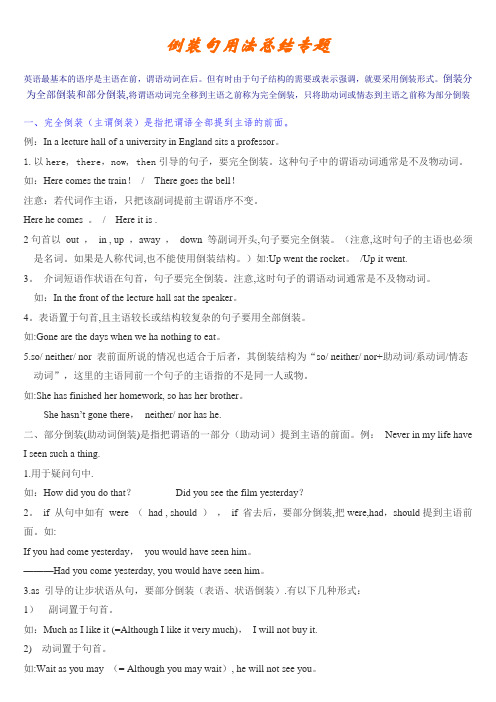
倒装句用法总结专题英语最基本的语序是主语在前,谓语动词在后。
但有时由于句子结构的需要或表示强调,就要采用倒装形式。
倒装分为全部倒装和部分倒装,将谓语动词完全移到主语之前称为完全倒装,只将助动词或情态到主语之前称为部分倒装一、完全倒装(主谓倒装)是指把谓语全部提到主语的前面。
例:In a lecture hall of a university in England sits a professor。
1.以here, there,now, then引导的句子,要完全倒装。
这种句子中的谓语动词通常是不及物动词。
如:Here comes the train!/ There goes the bell!注意:若代词作主语,只把该副词提前主谓语序不变。
Here he comes 。
/ Here it is .2句首以out ,in , up ,away ,down 等副词开头,句子要完全倒装。
(注意,这时句子的主语也必须是名词。
如果是人称代词,也不能使用倒装结构。
)如:Up went the rocket。
/Up it went.3。
介词短语作状语在句首,句子要完全倒装。
注意,这时句子的谓语动词通常是不及物动词。
如:In the front of the lecture hall sat the speaker。
4。
表语置于句首,且主语较长或结构较复杂的句子要用全部倒装。
如:Gone are the days when we ha nothing to eat。
5.so/ neither/ nor 表前面所说的情况也适合于后者,其倒装结构为“so/ neither/ nor+助动词/系动词/情态动词”,这里的主语同前一个句子的主语指的不是同一人或物。
如:She has finished her homework, so has her brother。
She hasn’t gone there,neither/ nor has he.二、部分倒装(助动词倒装)是指把谓语的一部分(助动词)提到主语的前面。
here there 引导的倒装句
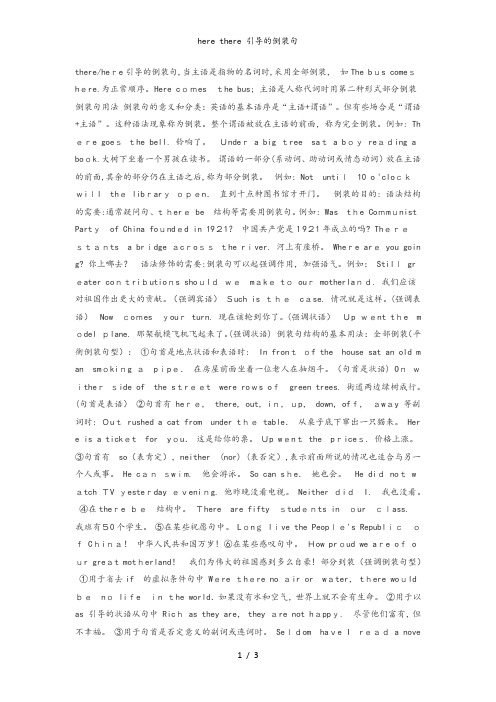
there/here引导的倒装句,当主语是指物的名词时,采用全部倒装,如The bus comeshere.为正常顺序。
Here comes the bus; 主语是人称代词时用第二种形式部分倒装倒装句用法倒装句的意义和分类:英语的基本语序是“主语+谓语”。
但有些场合是“谓语+主语”。
这种语法现象称为倒装。
整个谓语被放在主语的前面,称为完全倒装。
例如: Th ere goesthe bell. 铃响了。
Under a big tree sat a boy reading a book.大树下坐着一个男孩在读书。
谓语的一部分(系动词、助动词或情态动词)放在主语的前面,其余的部分仍在主语之后,称为部分倒装。
例如: Not until10 o'clockwill the libraryopen.直到十点种图书馆才开门。
倒装的目的: 语法结构的需要:通常疑问句、there be 结构等需要用倒装句。
例如: Was the Communist Partyof China founded in 1921?中国共产党是1921年成立的吗? Therestants a bridge acrossthe river. 河上有座桥。
Where are you goin g? 你上哪去?语法修饰的需要:倒装句可以起强调作用,加强语气。
例如: Still gr eater contributions shouldwemake to our motherland. 我们应该对祖国作出更大的贡献。
(强调宾语)Such is thecase. 情况就是这样。
(强调表语)Now comes your turn. 现在该轮到你了。
(强调状语)Up went the m odel plane. 那架航模飞机飞起来了。
(强调状语) 倒装句结构的基本用法:全部倒装(平衡倒装句型):①句首是地点状语和表语时: In frontof the house sat an old m an smoking apipe.在房屋前面坐着一位老人在抽烟斗。
倒装句讲解

几乎不,仅仅,决不 in
seldom, little, barely 仅够,几乎没有 rarely 不常,很少 nowhere无处,到处都无
at no time 决不 not …until hardly (scarcely)…when, no sooner….than(一…..就)
3、副词now,then,thus(因此,如此) 引导的句子里,谓语 come,follow,begin,end,be等.
Now comes your turn! Then followed another shot of gun. Thus ended the meeting.
4.in,out,down,up,over,away,off,back,below 等副词作状语置于句首时,谓语常用动词有 come,go,rush,等不及物动词。
全部谓语放在主语之前
* 部分倒装: __________
只把助动词,情态动词或连系动词 放在主语之前,谓语的主体部分 仍在主语之后
Can you tell the following ?
There is a table in the room.
完全倒装
Why did you do it like that?
注 意
1)当上述单词不提前时,则不倒装。
I seldom read newspaper before.
He had hardly finished his homework
when the light went out.
2)当这些词作形容词修饰主语时且置句首 时,句子不倒装。 Little work was done yesterday.
完全倒装与部分倒装
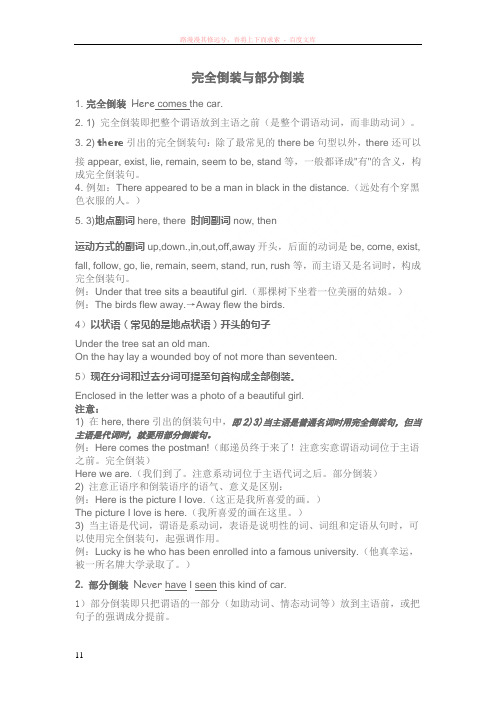
完全倒装与部分倒装1. 完全倒装Here comes the car.2. 1) 完全倒装即把整个谓语放到主语之前(是整个谓语动词,而非助动词)。
3. 2) there引出的完全倒装句:除了最常见的there be句型以外,there还可以接appear, exist, lie, remain, seem to be, stand等,一般都译成"有"的含义,构成完全倒装句。
4. 例如:There appeared to be a man in black in the distance.(远处有个穿黑色衣服的人。
)5. 3)地点副词here, there 时间副词now, then运动方式的副词up,down.,in,out,off,away开头,后面的动词是be, come, exist, fall, follow, go, lie, remain, seem, stand, run, rush等,而主语又是名词时,构成完全倒装句。
例:Under that tree sits a beautiful girl.(那棵树下坐着一位美丽的姑娘。
)例:The birds flew away.→Away flew the birds.4)以状语(常见的是地点状语)开头的句子Under the tree sat an old man.On the hay lay a wounded boy of not more than seventeen.5)现在分词和过去分词可提至句首构成全部倒装。
Enclosed in the letter was a photo of a beautiful girl.注意:1) 在here, there引出的倒装句中,即2)3)当主语是普通名词时用完全倒装句,但当主语是代词时,就要用部分倒装句。
例:Here comes the postman!(邮递员终于来了!注意实意谓语动词位于主语之前。
英语倒装句技巧讲解篇
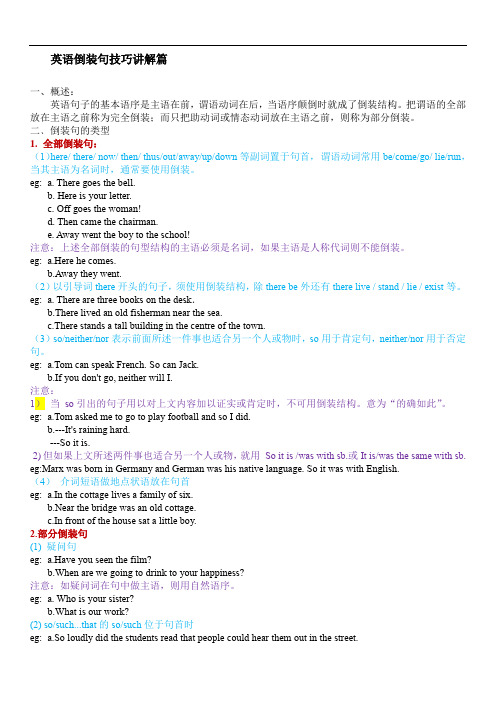
英语倒装句技巧讲解篇一、概述:英语句子的基本语序是主语在前,谓语动词在后,当语序颠倒时就成了倒装结构。
把谓语的全部放在主语之前称为完全倒装;而只把助动词或情态动词放在主语之前,则称为部分倒装。
二﹑倒装句的类型1.全部倒装句:(1)here/ there/ now/ then/ thus/out/away/up/down等副词置于句首,谓语动词常用be/come/go/ lie/run,当其主语为名词时,通常要使用倒装。
eg:a. There goes the bell.b. Here is your letter.c. Off goes the woman!d. Then came the chairman.e. Away went the boy to the school!注意:上述全部倒装的句型结构的主语必须是名词,如果主语是人称代词则不能倒装。
eg:a.Here he comes.b.Away they went.(2)以引导词there开头的句子,须使用倒装结构,除there be外还有there live / stand / lie / exist等。
eg:a. There are three books on the desk.b.There lived an old fisherman near the sea.c.There stands a tall building in the centre of the town.(3)so/neither/nor表示前面所述一件事也适合另一个人或物时,so用于肯定句,neither/nor用于否定句。
eg:a.Tom can speak French. So can Jack.b.If you don't go, neither will I.注意:1)当so引出的句子用以对上文内容加以证实或肯定时,不可用倒装结构。
意为“的确如此”。
倒装句讲解

3. Only when your identity has been checked, ________. A. you are allowed in B. you will be allowed in C. will you allow in D. will you be allowed in
全部谓语放在主语之前
* 部分倒装: __________
只把助动词,情态动词或连系动词 放在主语之前,谓语的主体部分 仍在主语之后
Can you tell the following ?
There is a table in the room.
完全倒装
Why did you do it like that?
“You’ve made great progress this term.” said the teacher. “Tom”,said his father, “ You shouldn’t make friends with such boys!”
注意:
1)主语是代词时,倒装不倒装都可以。 “Where are you going?”asked he. (He asked.)
I get up at seven and so does my brother. He didn’t do it and neither did I. He didn’t smoke, nor did he drink.
注意:
1)如果后一个句子只是单纯的重复前面 句子的意思,则不倒装.(…确实是) --It is hot today. --So it is. --He finished it on time. --So he did. 2)如按照别人的意思做了什么事,so也不 用倒装(…某人照办了) The teacher asked me to read louder ,
倒装句
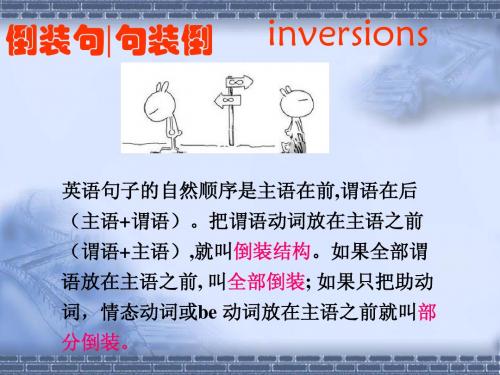
1) There ________. And here ________. A. goes the phone; she comes B. is the phone going; is she C. does the phone go; does she come D. the phone goes; come she 2) Out ________, with a stick in his hand. A. did he rush B. rushed he C. he rushed D. he did rush
2. 当表示地点的介词词组(如on the wall, under the tree, in front of the house, in the middle of the room等)在句首时。 At the foot of the hill lies a beautiful lake. The soldiers ran to the building, on the top of which flew a flag. East of the lake lie two towns. Under the tree was lying a wounded soldier. 3) Near the church ________ cottage. A. was such an old B. had a so old C. was such old a D. is so an old
3. There be结构。另外,在此结构中可以用 来代替be动词的动词有:exist, seem, happen, appear, live, rise, stand等。如: There stood a dog before him. There exist different opinions on this question.
英语倒装句
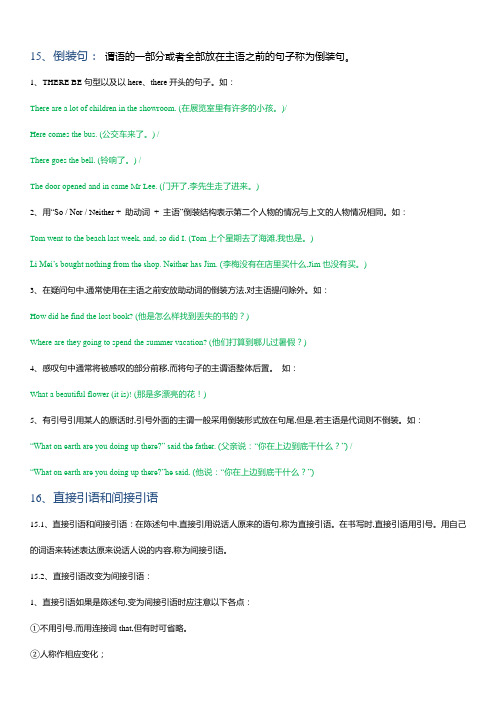
15、倒装句:谓语的一部分或者全部放在主语之前的句子称为倒装句。
1、THERE BE句型以及以here、there开头的句子。
如:There are a lot of children in the showroom. (在展览室里有许多的小孩。
)/Here comes the bus. (公交车来了。
) /There goes the bell. (铃响了。
) /The door opened and in came Mr Lee. (门开了,李先生走了进来。
)2、用“So / Nor / Neither + 助动词+ 主语”倒装结构表示第二个人物的情况与上文的人物情况相同。
如:Tom went to the beach last week, and, so did I. (Tom上个星期去了海滩,我也是。
)Li Mei’s bought nothing from the shop. Neither has Jim. (李梅没有在店里买什么,Jim也没有买。
)3、在疑问句中,通常使用在主语之前安放助动词的倒装方法,对主语提问除外。
如:How did he find the lost book? (他是怎么样找到丢失的书的?)Where are they going to spend the summer vacation? (他们打算到哪儿过暑假?)4、感叹句中通常将被感叹的部分前移,而将句子的主谓语整体后置。
如:What a beautiful flower (it is)! (那是多漂亮的花!)5、有引号引用某人的原话时,引号外面的主谓一般采用倒装形式放在句尾,但是,若主语是代词则不倒装。
如:“What on earth are you doing up there?” said the father. (父亲说:“你在上边到底干什么?”) /“What on earth are you doing up there?”he said. (他说:“你在上边到底干什么?”)16、直接引语和间接引语15.1、直接引语和间接引语:在陈述句中,直接引用说话人原来的语句,称为直接引语。
倒装结构1
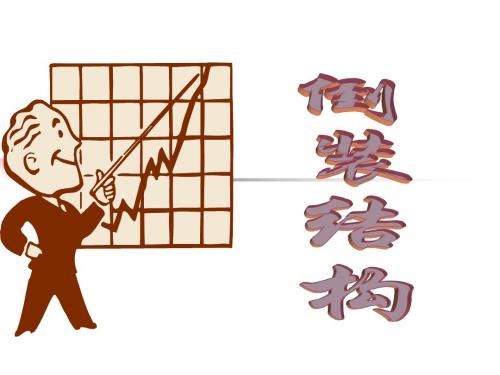
2.Not only ...but also…,No sooner…than… Hardly/Scarcely…when 句式中, 从句倒装,主句不倒装
Not only could she type but also she could operate the computer. No sooner had the bell rung than than the gate opened and out went groups o Hardly had he got on the bus when he heard a shout.
注意only修饰其他成分不引 起倒装。 Only doctor can save him .
4.在so…that的结果状语从句中, so位于句首并修饰形容词或副词
So fat is she that her classmates often make fun of her. (=She is so fat that her classmates often make fun of her.) So clearly did she explain the text that we could understand it.
.
4.分词结构位于句首
Lying on the grass are a group of children. Seated on the floor are a group of children.
5.表语位于句首
In each class are 48 students. Happy is he who has a sound mind and body.
倒装句

• 13. At the foot of the mountain ______ . • A.lie a beautiful lake • B.does a beautiful lake lie • C.lies a beautiful lake • D.do a beautiful lake lie • 分析 答案 C。 At the foot of the mountain在句中作地点状语放在句首,句子 要倒装。地点状语放在句首,而且之后跟着 come, lie, stand, walk等不及物动词时,常 用倒装。整个动词放在主语之前,不用借助于 do 或did, 这叫完全倒装。
• 14.6 as, though 引导的倒装句 • as / though引导的让步从句必须将表语或状 语提前(形容词, 副词, 分词, 实义动词提前)。 但需注意: • Busy as he is , he won’t miss the game. 1) 句首名词不能带任何冠词。 Child as he is , he knows a lot about spaceships。 2) 句首是实义动词, 其他助动词放在主语后。 如果实义动词有宾语和状语,随实义动词一起放 在主语之前。例如: • Try hard as he will, he never seems able to do the work satisfactorily. • 他工作很努力,但总不能让人满意。
• 4.Not until the early years of the 19th century ————what heat is. • A.man Did know B.man knew • C.didn't man know D.did man know • 分析 答案D。否定意义的副词not放在句首时要用倒 装语序。 • 5.Look, ______ . • A.here the bus come B.here is the bus coming • C.here comes the bus D.here the bus is coming • 分析 答案C。以here或there等副词开头的句子要用 倒装语序,以示强调。如果主语是代词,就不用倒装。 • 6. ______ , he knows a lot of things. • A.Child as he is B.Child as he is • C.A child as is he D. Child as is he • 分析 答案 b。 Child as he is, = Although he is a child, as引导让步状语从句常用倒装语序。注意, 单数名词放在句首,不用冠词。
英语倒装句
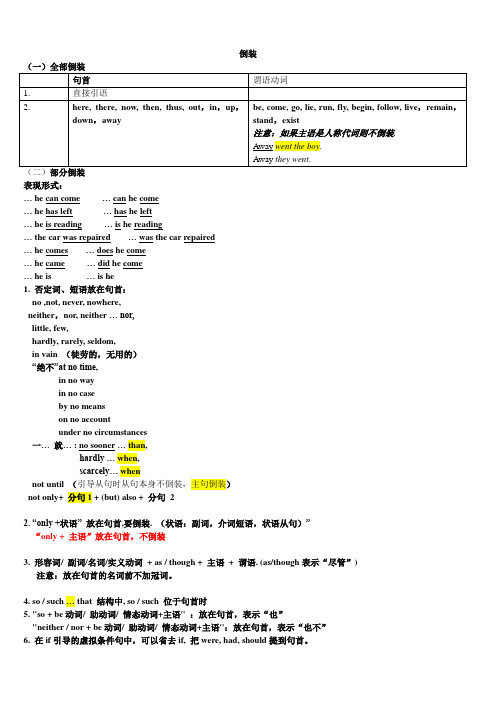
倒装(二)部分倒装表现形式:… he can come … can he come… he has left … has he left… he is reading … is he reading… the car was repaired … was the car repaired… he comes … does he come… he came … did he come… he is … is he1. 否定词、短语放在句首:no ,not, never, nowhere,neither,nor, neither … nor,little, few,hardly, rarely, seldom,in vain (徒劳的,无用的)“绝不”at no time,in no wayin no caseby no meanson no accountunder no circumstances一…就… : no sooner … than,hardly … when,scarcely… whennot until (引导从句时从句本身不倒装,主句倒装)not only+ 分句1 + (but) also + 分句22. “only +状语”放在句首,要倒装. (状语:副词,介词短语,状语从句)”“only + 主语”放在句首,不倒装3. 形容词/ 副词/名词/实义动词+ as / though + 主语+ 谓语. (as/though表示“尽管”)注意:放在句首的名词前不加冠词。
4. so / such … that 结构中, so / such 位于句首时5. "so + be动词/ 助动词/ 情态动词+主语" :放在句首,表示“也”"neither / nor + be动词/ 助动词/ 情态动词+主语":放在句首,表示“也不”6. 在if引导的虚拟条件句中,可以省去if, 把were, had, should提到句首。
倒装结构

五,由neither或nor引起的,表示前面所说的 情况也适用于另一个人(或物)的句子,如: 1.-- I won‘t do such a thing. – Neither / Nor will I. 2. If you won‘t go, neither shall I. 3.-- I haven‘t done my homework. – Neither / Nor have I. 4. I didn‘t read the notice on the bulletin board, nor did he.
高三英语总复习语法系列训练
倒装结构
倒装语序分为“全部倒装”和“部 分倒装”。在全部倒装的句子中,整 个谓语都放在主语的前面;在部分倒 装的句子中,只是谓语中的一部分 (如助动词、情态动词或系动词be等) 放在主语前面,其余部分仍放在主语 后面。下面将常见的倒装情况分述如 下:
一 、由 there, here或 now等引起 ,谓语为 come
as, though 引导的倒装句 as / though引导的让步从句必须将表 语或状语提前 (形容词, 副词, 分词, 实义动词提前)。 注意: 1)句首名词不能带任何冠词。 2)句首是实义动词, 其他助动词放在主 语后.如果实义动词有宾语和状语,随 实义动词一起放在主语之前。
e.g Try hard as he will, he never seems able to do the work satisfactorily. 注意: 让步状语从句中,有though, although时,后面的主句不能有but, 但是 though 和yet可连用。
Exercises:
1.-- I went to GZ yesterday. -- ________________. (我也是) So did I 2. — I didn‘t finish homework last night. Neither/Nor did Mary --- ____________________(玛丽也没有) 3. — Jane has been to Beijing for three times and she likes it very much. So it is with my father — ______________________(我爸爸也是) It is the same with my father
倒装句 高中英语语法
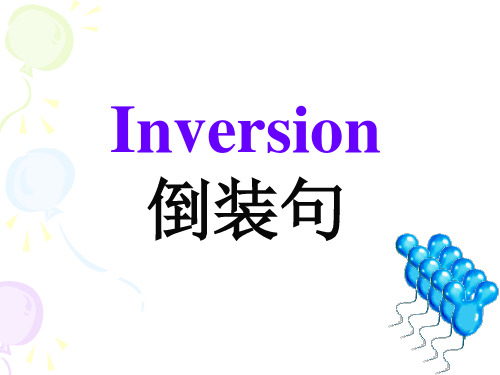
1.全部倒装 1) here, there, now, then, thus等副词置于句 首, 谓语动词常用be, come, go, lie, run。
1. There goes the bell.
—There it goes.
2. Then came the chairman.
—Then he came.
2. Light travels so fast that it is hard for us to imagine its speed. —So fast does light travel that ……
3. He is such a naughty boy that we don’t know how to deal with him. —Such a naughty boy is he that …… 其结构为:such+a/an+形容词+名词+主句助 动词+主语+句子剩余部分。
* Tom asked me to go to play football and s_o__I_d_i_d_. * —It‘s raining hard.
—So it is
注意: 当so引出的句子用以对上文内容加以证实或肯定时, 不可用倒装结构。意为“的确如此”。
* He is American and he can‘t speak Chinese. So it is with his wife.
3. Here is your letter.
—Here it is.
注意:1.上述句型结构的主语必须是名词,如果主 语是人称代词则不能完全倒装.
2.此结构通常只用一般现在时和一般过去时。
- 1、下载文档前请自行甄别文档内容的完整性,平台不提供额外的编辑、内容补充、找答案等附加服务。
- 2、"仅部分预览"的文档,不可在线预览部分如存在完整性等问题,可反馈申请退款(可完整预览的文档不适用该条件!)。
- 3、如文档侵犯您的权益,请联系客服反馈,我们会尽快为您处理(人工客服工作时间:9:00-18:30)。
there/here引导的倒装句,当主语是指物的名词时,采用全部倒装,如The bus comes he re.为正常顺序。
Here comes the bus;主语是人称代词时用第二种形式部分倒装倒装句用法倒装句的意义和分类:英语的基本语序是“主语+谓语”。
但有些场合是“谓语+主语”。
这种语法现象称为倒装。
整个谓语被放在主语的前面,称为完全倒装。
例如:There goes the bell. 铃响了。
Under a big tree sat a boy reading a book.大树下坐着一个男孩在读书。
谓语的一部分(系动词、助动词或情态动词)放在主语的前面,其余的部分仍在主语之后,称为部分倒装。
例如:Not until 10 o'clock will the library open. 直到十点种图书馆才开门。
倒装的目的:语法结构的需要:通常疑问句、there be 结构等需要用倒装句。
例如:Was the Communist Party of China founded in 1921 中国共产党是1921年成立的吗There stants a bridge across the river. 河上有座桥。
Where are you going 你上哪去语法修饰的需要:倒装句可以起强调作用,加强语气。
例如:Still greater contributi ons should we make to our motherland. 我们应该对祖国作出更大的贡献。
(强调宾语)Such is the case. 情况就是这样。
(强调表语)Now comes your turn. 现在该轮到你了。
(强调状语)Up went the model plane. 那架航模飞机飞起来了。
(强调状语)倒装句结构的基本用法:全部倒装(平衡倒装句型):①句首是地点状语和表语时:In front of the house sat an old man smoking a pipe. 在房屋前面坐着一位老人在抽烟斗。
(句首是状语)On wither side of the street were rows of green trees. 街道两边绿树成行。
(句首是表语)②句首有here, there, out, in, up, down, off, away 等副词时:Out ru shed a cat from under the table. 从桌子底下窜出一只猫来。
Here is a ticket for you. 这是给你的票。
Up went the prices. 价格上涨。
③句首有so(表肯定),neither (nor)(表否定),表示前面所说的情况也适合与另一个人或事。
He can swim. 他会游泳。
S o can she. 她也会。
He did not watch TV yesterday evening. 他昨晚没看电视。
Neither did I. 我也没看。
④在there be 结构中。
There are fifty students in our class. 我班有50个学生。
⑤在某些祝愿句中。
Long live the People's Republic of China! 中华人民共和国万岁!⑥在某些感叹句中。
How proud we are of our great motherland! 我们为伟大的祖国感到多么自豪!部分到装(强调倒装句型)①用于省去if 的虚拟条件句中We re there no air or water, there would be no life in the world.如果没有水和空气,世界上就不会有生命。
②用于以as 引导的状语从句中Rich as they are, they are not happy.尽管他们富有,但不幸福。
③用于句首是否定意义的副词或连词时。
Seldom have I re ad a novel so touching as this. 我难得读到如此动人的小说。
Hardly did I think it possi ble. 我几乎认为这是不可能的。
④用于疑问句。
When did you begin to learn English 你什么时候开始学英语的⑤句首是only 、后边跟状语的句子中Only in this way can yo u learn English well. 只有这种方法,你才能学好英语。
⑥直接引语的全部或一部分在句首时。
"Do you think my clothes fit well" asked the emperor.“你认为我的衣服非常合身吗”皇帝问道。
"Mr smith" said mary,"May I borrow your pen" “史密斯先生”玛丽说,“我可以借一下你的钢笔吗” ⑦某些祝愿的句子(谓语带有情态动词,则为部分倒装)。
May you succeed. 祝您成功。
重难点分析1.由疑问词或有疑问词修饰的名词作主语的特殊疑问句不倒装。
如:Who is your maths teacher 谁是你的数学老师(who 是主语)Which bicycle is yours 哪辆自行车是你的(which 是定语,修饰bicycle )2.在以here, there, now, then… 等开头的句子中here, there 强调地点但不指具体的地点,只用来引起人们的注意,要重读。
同样now, then 强调时间,也并不指具体时间,只引起人们的注意,也要重读。
如:There comes our teacher. 我们的老师来了。
在时态方面要注意,除了以the n 开头的句子用过去时外,其余均用一般现在时。
如:Then came a new problem. 那时出现了新问题。
3.主语是人称代词时不倒装。
如:Here we are. 我们到了。
(Here are w e 错)Away he went. 他走开了。
(Away went he.错)There he comes. 他来了。
(Th ere comes he. 错)4.为了使句子生动、流畅,常把in, out, down, up, away, off 等,副词放在句首,采用全部倒装语序,不加助动词(do, does等)句子的动词一般都是不及物的行为动词。
如:In came the manager. 经理来了。
不说:In did the manager come. 当主语是人称代词时,一般只把副词放在句首,不倒装。
例如:In he came and the less on began.他进来了,于是开始上课。
不说:In came he and lesson began. 放在句首,但修饰的不是状语而是主语时,不倒装。
如:Only John is allowed to enter the lab. 只有约翰被允许进入实验室。
Only the boy himself knows what he is going to be. 只有这孩子本人知道他将来的前途。
6.以so 开头的句子。
如果只是重复前面一句话的意思,不倒装。
如:It was very cold yesterday.昨天很冷。
So it was.正是这样。
He did a good j ob. 他干的很出色。
So he did. 确实如此。
7.以not only 开头的句子要倒装,但but al so 后面的句子不倒装。
如:Not only did he speak more correctly, but also he spoke more easily. 不仅他说得更准确,而且他说得也更轻松。
8.以not until 开头的句子主句要倒装,没有助动词时要加助动词。
如:Not until Mother came back did it stop raining. 直到妈妈回来雨才停。
9.带有否定意义的副词和状语词组放在句首时,句子要倒装,这样的副词常见的有:no sooner…than, hardly…when, not until, never, hardly, seldom, scarece ly, little, barely, at no time(=never) 等。
在使用时要特别注意以hardly(barely/scarc ely)…wh en 和no sooner…than 开头的句子。
在这种倒装句中,主句倒装从句不倒装。
如:Hardl y had he got into the room when the telephone rang. 他一进屋,电话就响了。
10.频度状语如often, seldom 等,地点状语如in front of, in the middle of 等,位于句首时,句子要倒装,没有助动词时要加助动词。
如:Seldom does it snow here.这里很少下雪。
1 1.充当表语的单数名词放在句首时,不加任何冠词,也不用复数形式。
如:Child as he is,he knows a lot .虽然他是个孩子,可知道的事挺多。
12.为了强调某一动作或使句子平稳和谐,将表语(形容词、现在分词、过去分词)放在句首并倒装。
如:Late as it was, he still continued learning in a poor light. 虽然天色已晚,他仍继续在微弱的光线下学习。
Late as it was表示让步,是as 的一种用法,意思相当于Though it was late 。
再举一例:Written on the box is the model of the machine. 箱子上写了机器的型号。
这个句子的正常语序是:The model of the machine is written on the box. written 是过去分词在句中作表语。
注意本句不是被动语态,而是系表结构。
